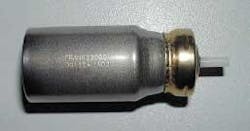From in-depth engraving to marking on the fly
Diode-pumping Nd:YAG lasers increases their wall plug efficiency fivefold and the lifetime of the pumping module by more than 20-fold, compared to lamp-pumped Nd:YAG. When all cost factors are considered, the cost of ownership can be smaller than that of lamp-pumped lasers.
The keys to market success are the high level of reliability and modularity of these lasers. Diode laser products must be scalable to fulfil the varying requirements of materials to be processed and the processing speed. Additional features such as fiber coupling and exchangeable mode aperture may be necessary, depending on the individual customer. Of equal importance is an industrial-grade beam delivery system that consists of optics, scanner and software control. Finally, rapid fab-line integration requires that systems be externally controlled from computer integrated manufacturing (CIM) devices via computer numerical control (CNC) or programmable logic control (PLC) input.
null
A typical system, the Raymarker from LaserPluss AG (Kierschweiler, Germany), is shown in Figure 1. A diode-pumped laser, the DiNY from IB Laser (Orlando, FL), just 457mm long, is shown in the lower portion. The laser diodes, shown schematically, are transversally pumped by proprietary IB Laser technology. Thus optical-to-optical conversion of 45 percent efficiency is achieved, a considerable improvement with respect to the 2–5 percent of flashlamp-pumped systems.
The beam profile can be adjusted from high-power multimode emission to Gaussian TEM00 mode. If a YAG-rod is pumped transversely, the intermediate low-order modes often resemble a top-hat intensity profile, which may be preferable to the Gaussian mode for those applications where laser energy has to be delivered uniformly. This can be done by simply replacing apertures in the resonator, without changing the optical alignment of the laser cavity itself or by remote-controlled switching.
Thermal lensing is reduced because of the good conversion efficiency of diode-pumped lasers. The same amount of output power can be extracted from a much smaller resonator. The decrease in resonator length results in shorter pulses and a peak power >100 kW. This, combined with the TEM00 mode profile, allows power density to be scaled to >1 MW/cm2 on the target. High peak power is a frequent requirement in threshold-type processes such as metal marking where beam reflectivity from the surface may be a problem. A smaller pulsewidth reduces thermal diffusion into the sample, because a smaller material volume is heated, thereby increasing the material extraction rate for engrave mode marking.
When starting an Nd:YAG laser, internal laser dynamics typically result in power overshoots of several hundred percent or more for the first pulse, which may be detrimental for the process. IB Laser has developed a real-time first pulse control technology to ensure a stable accuracy in all operation regimes. Programmable hardware logic arrays (FPGAs) look at real-time external trigger input and then actively stabilize the laser emission with a 1MHz bandwidth, even if the laser is externally triggered.
A complete, mobile and turnkey marking unit requires a beam delivery arrangement that consists of a beam expander, an X/Y scanning head and a telecentric lens. Figure 1 shows the system, which can control the processing steps in time, space and energy domains.
null
Figure 2 shows the result of a high-energy laser engraving process. In this application the actual part is approximately 10cm wide and 2.5cm high and the depth of the engraving is 6 mm. About 3–7 mm3 of material is extracted per minute, depending on the material being processed. Engraving letters 0.25mm wide by 0.5mm deep takes about 30 seconds with a 100W DiNY laser. This is in the high accuracy regime, in which the scanning system performs a beam steering motion of about one inch per second, a speed that can be achieved with an accuracy of better than 2 µm.
If high throughput is required, the sample can be moved during the marking process. In this 'on-the-fly' system real-time control in the microsecond range and the scanners follow a predetermined path as the sample moves underneath the focusing lens.
null
Figure 3 shows the label for a pharmaceutical aerosol container with 20 letters written in just 0.16 seconds. Throughput of the marking system, in this case 200 cans per minute, is produced with an economical 30W laser system. At a speed of 30 ft/sec the positioning accuracy is still 200 µm; sufficient for industrial-grade, readable, falsification-protected marking.
These are two examples for metal marking. In the case of plastics, shorter pulses also lead to small volume heating, higher contrast and low thermal damage to the surrounding area. Color switching occurs on nearly all plastics that are specially prepared. Color transformed, carbon particles are embedded into the plastic to a depth of 100 µm, creating a non-abrasive mark inside of the plastic material.
Compared with more traditional technology, such as attached labels, the economics of laser marking can be calculated as follows; assume a labelling requirement of 106 parts; the laser takes 10 seconds time and $0.05 per label, this leads to a system amortization time of just one year.
Bernard Smandek and Frank Maßmann are with IB Laser, Berlin, Germany. Werner Schulz is with LaserPluss AG, Idar Oberstein, Germany. Contact LaserPluss by e-mail at [email protected].



